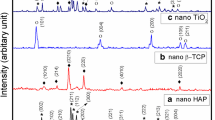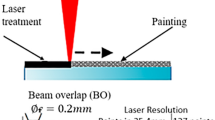Abstract
Rutile tin dioxide (SnO2) layers have been used in many industrial applications due to their electrical, optical, electrochemical properties, and high-chemical stability. Moreover, they can find application for coating in biomedical devices due to their antimicrobial effect and high biocompatibility. So far, for such applications, researchers have attempted to fabricate SnO2 nanorods as reinforcing fillers for biopolymer implants as scaffolds for tissue engineering. The biocidal activity of such structures against gram-positive bacteria S. aureus and gram-negative bacteria E. coli has been demonstrated, as well as their non-toxicity. Applying SnO2 using the sol–gel method, on the other hand, showed an increase in the corrosion resistance of A36 steel. In this study, SnO2 films were grown on 316LVM steel, commonly used for implants as biocompatible and antibacterial layer. A number of different deposition techniques can be used to produce such a layer, however, the authors have chosen the atomic layer deposition (ALD) technique, which ensures high-layer uniformity, low density of defects, and high smoothness. The ALD method allows for even coverage of the component with a thin film. By controlling the process parameters, such as the number of cycles and temperature, we can obtain different layer thicknesses with various properties. Studies included chemical composition (AES), pitting corrosion resistance, potentiodynamic tests, electrochemical impedance spectroscopy (EIS), ion permeability, and scanning electron microscope (SEM) surface observations. According to the obtained data, it was found that the results strictly depend on the parameters of the process.
Access this chapter
Tax calculation will be finalised at checkout
Purchases are for personal use only
Similar content being viewed by others
Literature
Godbole N, Yadav S, Ramachandran M, Belemkar S (2016) A review on surface treatment of stainless steel orthopedic implants. Int J Pharm Sci Rev Res 36
Basiaga M, Kajzer W, Walke W, Kajzer A, Kaczmarek M (2016) Evaluation of physicochemical properties of surface modified Ti6Al4V and Ti6Al7Nb alloys used for orthopedic implants. Mater Sci Eng C 68. https://doi.org/10.1016/j.msec.2016.07.042
Marin E, Guzman L, Lanzutti A, Ensinger W, Fedrizzi L (2012) Multilayer Al 2O 3/TiO 2 atomic layer deposition coatings for the corrosion protection of stainless steel. In: Thin Solid Films
Pantoja M, Velasco F, Abenojar J, Martinez MA (2019) Development of superhydrophobic coatings on AISI 304 austenitic stainless steel with different surface pretreatments. Thin Solid Films 671. https://doi.org/10.1016/j.tsf.2018.12.016
Hedberg Y, Karlsson ME, Blomberg E, Odnevall Wallinder I, Hedberg J (2014) Correlation between surface physicochemical properties and the release of iron from stainless steel AISI 304 in biological media. Colloids Surf B Biointerf 122. https://doi.org/10.1016/j.colsurfb.2014.06.066
Iqbal J, Jilani A, Ziaul Hassan PM, Rafique S, Jafer R, Alghamdi AA (2016) ALD grown nanostructured ZnO thin films: effect of substrate temperature on thickness and energy band gap. J King Saud Univ Sci 28. https://doi.org/10.1016/j.jksus.2016.03.001
Jang JT, Ryu H, Lee WJ (2013) Effect of ALD surface treatment on structural and optical properties of ZnO nanorods. Appl Surf Sci 276. https://doi.org/10.1016/j.apsusc.2013.03.133
Yuan NY, Wang SY, Tan CB, Wang XQ, Chen GG, Ding JN (2013) The influence of deposition temperature on growth mode, opticaland mechanical properties of ZnO films prepared by the ALD method. J Cryst Growth 366. https://doi.org/10.1016/j.jcrysgro.2012.12.024
Campoccia D, Montanaro L, Arciola CR (2013) A review of the biomaterials technologies for infection-resistant surfaces. Biomaterials 34
Zhang E, Zhao X, Hu J, Wang R, Fu S, Qin G (2021) Antibacterial metals and alloys for potential biomedical implants. Bioact Mater 6
Ferraris S, Spriano S (2016) Antibacterial titanium surfaces for medical implants. Mater Sci Eng C 61
Verissimo NC, Geilich BM, Oliveira HG, Caram R, Webster TJ (2015) Reducing Staphylococcus aureus growth on Ti alloy nanostructured surfaces through the addition of Sn. J Biomed Mater Res Part A 103. https://doi.org/10.1002/jbm.a.35517
Kang Y, Park J, Kim DW, Kim H, Kang YC (2016) Controlling the antibacterial activity of CuSn thin films by varying the contents of Sn. Appl Surf Sci 389. https://doi.org/10.1016/j.apsusc.2016.08.041
Vasanthi M, Ravichandran K, Jabena Begum N, Muruganantham G, Snega S, Panneerselvam A, Kavitha P (2013) Influence of Sn doping level on antibacterial activity and certain physical properties of ZnO films deposited using a simplified spray pyrolysis technique. Superlattices Microstruct 55. https://doi.org/10.1016/j.spmi.2012.12.011
ISO/ES10993–15 (2001) Biological evaluation of medical devices—Part 15: Identification and quantification of degradation products from metals and alloys. Int Stand
Pan J, Thierry D, Leygraf C (1996) Electrochemical impedance spectroscopy study of the passive oxide film on titanium for implant application. Electrochim Acta 41. https://doi.org/10.1016/0013-4686(95)00465-3
Barranco V, Escudero ML, García-Alonso MC (2007) 3D, chemical and electrochemical characterization of blasted TI6Al4V surfaces: Its influence on the corrosion behaviour. Electrochim Acta 52. https://doi.org/10.1016/j.electacta.2006.12.031
Vlasak R, Klueppel I, Grundmeier G (2007) Combined EIS and FTIR-ATR study of water uptake and diffusion in polymer films on semiconducting electrodes. Electrochim Acta 52. https://doi.org/10.1016/j.electacta.2007.07.003
Mohan L, Anandan C, Rajendran N (2015) Electrochemical behaviour and bioactivity of self-organized TiO2 nanotube arrays on Ti-6Al-4V in Hanks’ solution for biomedical applications. Electrochim Acta 155. https://doi.org/10.1016/j.electacta.2014.12.032
Hodgson AWE, Mueller Y, Forster D, Virtanen S (2002) Electrochemical characterisation of passive films on Ti alloys under simulated biological conditions. Electrochim Acta 47. https://doi.org/10.1016/S0013-4686(02)00029-4
Lee KM, Chen CY, Tsai YT, Lin LC, Wu CG (2013) Efficient and stable back-illuminated sub-module dye-sensitized solar cells by decorating SiO2 porous layer with TiO2 electrode. RSC Adv 3. https://doi.org/10.1039/c3ra41687a
Lasia A (2002) Electrochemical impedance spectroscopy and its applications BT—modern aspects of electrochemistry. In: Modern aspects of electrochemistry
Zheng X, Cheng W, Ji C, Zhang J, Yin M (2020) Detection of metal ions in biological systems: A review. Rev Anal Chem 39
Basiaga M, Walke W, Staszuk M, Kajzer W, Kajzer A, Nowińska K (2017) Influence of ALD process parameters on the physical and chemical properties of the surface of vascular stents. Arch Civ Mech Eng 17. https://doi.org/10.1016/j.acme.2016.08.001
Walke W, Paszenda Z, Pustelny T, Opilski Z, Drewniak S, Kos̈cielniak-Ziemniak M, Basiaga M (2016) Evaluation of physicochemical properties of SiO2-coated stainless steel after sterilization. Mater Sci Eng C 63. https://doi.org/10.1016/j.msec.2016.02.065
Szewczenko J, Jaglarz J, Basiaga M, Kurzyk J, Paszenda Z (2013) Optical methods applied in thickness and topography testing of passive layers on implantable titanium alloys. Opt Appl 43. https://doi.org/10.5277/oa130121
Acknowledgements
The project was funded by the National Science Center, Poland allocated on the basis of the decision No. 2018/29/B/ST8/02314.
Author information
Authors and Affiliations
Corresponding author
Editor information
Editors and Affiliations
Rights and permissions
Copyright information
© 2022 The Author(s), under exclusive license to Springer Nature Switzerland AG
About this chapter
Cite this chapter
Basiaga, M. et al. (2022). Electrochemical Behavior of SnO2 Layer Deposited on Biomaterials Used in Bone Surgery. In: Öchsner, A., Altenbach, H. (eds) Engineering Design Applications IV. Advanced Structured Materials, vol 172. Springer, Cham. https://doi.org/10.1007/978-3-030-97925-6_4
Download citation
DOI: https://doi.org/10.1007/978-3-030-97925-6_4
Published:
Publisher Name: Springer, Cham
Print ISBN: 978-3-030-97924-9
Online ISBN: 978-3-030-97925-6
eBook Packages: EngineeringEngineering (R0)




